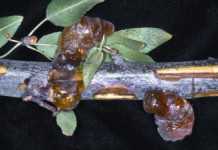How To ID Almond Cankers

Cankers, which are areas of dead tree tissue, can occur on the trunks, scaffolds, and branches of almond trees. Appearing as darkened, depressed areas of bark, they have definite margins where the healthy and dead tissue meet. In many cases, the margin of the canker is outlined by “gum balls,” or sap that is exuded as the tree’s defense pathways are activated. Cankers may be caused by physical injuries such as sunburn or shaker damage, as well as plant pathogens which include bacteria and fungi. In regard to plant pathogens, major fungal canker problems are consistently found within almond orchards, causing tree and scaffold loss.
Recently, several almond orchards have been observed with band, canopy, and pruning wound cankers. Found throughout California’s San Joaquin and Sacramento Valleys, these problems have caused significant damage in newer plantings and have frequently been observed on 3- to 6-year-old trees. It appears that all varieties are susceptible and extensive damage has been observed on numerous popular varieties, including Nonpareil, Padre, Carmel, and Butte.
Traditionally, these cankers were thought to be caused by a single pathogen, Botryosphaeria dothidea. However, recent molecular studies have shown that a half dozen different species within the family of Botryosphaeriaceae have been isolated from cankers within almonds. This evidence demonstrates the complexity of this group of pathogens and may partially explain why disease epidemiology and control strategies for these diseases have been difficult to achieve. Here’s a look at each of these various types of cankers:
Band Canker — Throughout the growing season, narrow, irregular cankers can extend laterally around the trunk or scaffolds. The cankers arise from small growth cracks and exude amber or clear gum. Upon bark removal, the canker becomes evident. This disease is often observed on vigorously grown trees. Tree decline occurs, but the tree does not always die. Observations and research have shown that trees only need to be removed from the orchard if they are collapsing or dead. Surviving trees will recover from the disease. Upon tree removal, the stump must be excavated in order to completely remove the disease from the orchard. Sprinkling of water onto tree trunks has been shown to increase disease severity. The use of “splitters” is advised for sprinklers in order to redirect water away from the tree trunk. Strategies to reduce vigor within severely infested young orchards may be beneficial.
Canopy Cankers — This is a newly discovered phase of the disease that occurs on scaffolds and within the canopy. These cankers are associated with pruning wounds, lenticels, cracks at the base of branches, and peduncles. Infections can occur throughout the year. Upon infection, the canker will grow outward, causing copious gumming. Infections occurring within the canopy are often minor, and can be removed by pruning 3 to 6 inches below the canker margin. These sites may serve as a reservoir of the pathogens if left within the orchard.
Pruning Wound Cankers — Pruning wound cankers have been observed on all major varieties and are the most damaging to orchards. Cankers that develop on the primary or secondary scaffolds of young trees will lead to the loss of these scaffolds and eventual tree death. Sometimes infection occurs within the wind cracks found in the base of the scaffolds. Removal of the infected scaffold may be possible, but all of the diseased wood must be removed or the infection will remain. To stave off infection, proper structuring and tying of trees to reduce wind breakage, as well as pruning when the weather forecast is clear, is advised. Delayed spring pruning or late fall pruning to avoid the rains may be necessary. Pruning cuts should not be cut flush with the tree, but rather be made outside of the branch collar as this increases the rate of healing. This disease has been noted to have a high occurrence around rivers, sloughs, and other riparian areas. It is important to note that once the tree is infected, there are no fungicide or nutrient sprays that can cure this disease.
Play Prevent Defense
Control strategies for these three diseases have been difficult to develop due to the complexity of the fungi’s life cycle. Initial infection is thought to occur through airborne spores that move into an orchard from a residual population. Recent research has shown that uninfected trees can harbor populations of these fungi. It is thought that the fungus has the ability to infect and survive on dead bark, remaining dormant until conducive conditions occur for tree infection. Since these fungi are found on many species within the environment, it is difficult — if not impossible — to provide adequate control through application of fungicides. Strategies that prevent infection (i.e. proper pruning, reducing excessive vigor) should be utilized to help reduce the severity of these diseases within the orchard.
Modern farming practices may make these wounds more or less susceptible than what was previously described. Previous research has shown that pruning wounds larger than ½-inch diameter may be susceptible for three to five days. Larger cuts are susceptible longer. Covering wounds with paints did not appear to increase wound healing, but may prevent the wound from fungal infection. Wound susceptibility and the feasibility of protecting tree wounds and trunks with fungicides are currently being researched.










